Management Accounting Report: Costing Techniques and Budgetary Control
VerifiedAdded on 2023/01/23
|22
|5822
|69
Report
AI Summary
This report delves into the realm of management accounting, focusing on its application within Equilibrium Asset Management, a financial consultancy firm, and its client, Ryder Architecture, a construction company. The report explores the core principles of management accounting, emphasizing its role in internal decision-making and strategic planning. It examines various management accounting systems, including cost accounting, inventory management, price optimization, and job order costing, highlighting their benefits and applications. Furthermore, the report analyzes different management accounting reporting methods, such as performance reports, budget reports, and accounts receivable reports, and discusses their integration into organizational processes. The report also covers costing techniques, including direct and indirect costs, cost analysis, and cost-volume-profit analysis, providing a comprehensive understanding of cost management. Finally, the report explores the advantages and disadvantages of different planning tools used for budgetary control and concludes with an overview of how organizations adapt their management accounting systems to respond to financial challenges.
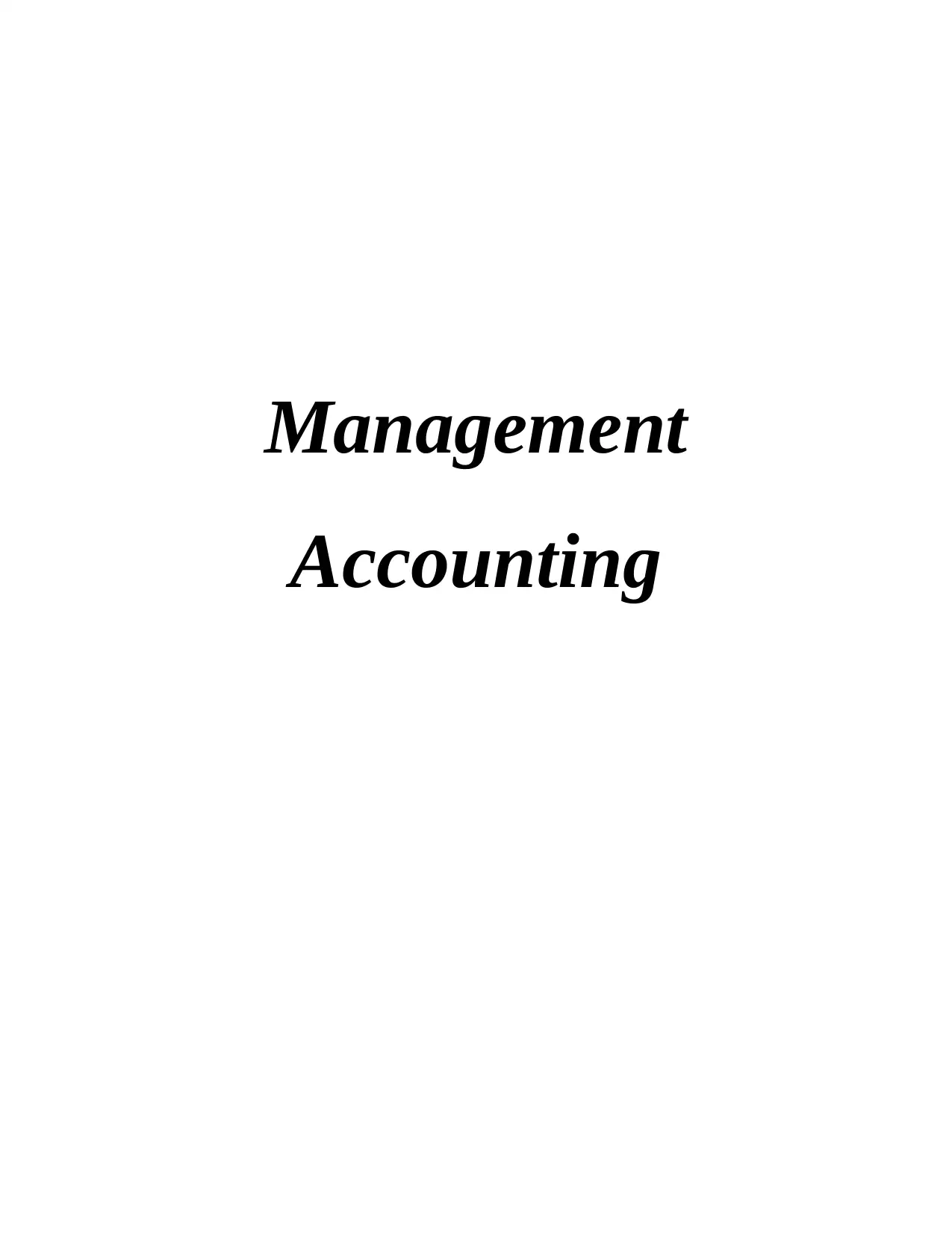
Management
Accounting
Accounting
Paraphrase This Document
Need a fresh take? Get an instant paraphrase of this document with our AI Paraphraser
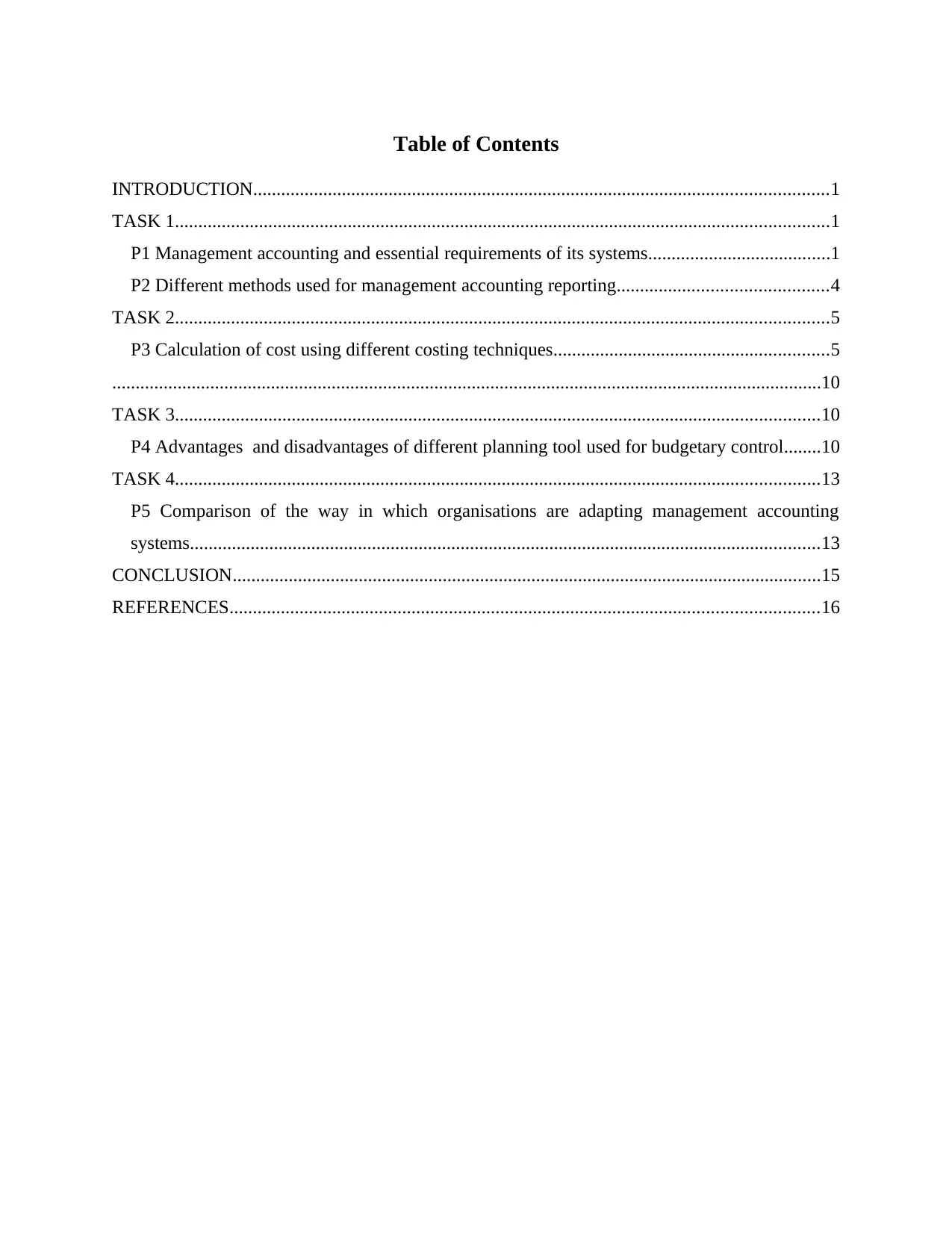
Table of Contents
INTRODUCTION...........................................................................................................................1
TASK 1............................................................................................................................................1
P1 Management accounting and essential requirements of its systems.......................................1
P2 Different methods used for management accounting reporting.............................................4
TASK 2............................................................................................................................................5
P3 Calculation of cost using different costing techniques...........................................................5
........................................................................................................................................................10
TASK 3..........................................................................................................................................10
P4 Advantages and disadvantages of different planning tool used for budgetary control........10
TASK 4..........................................................................................................................................13
P5 Comparison of the way in which organisations are adapting management accounting
systems.......................................................................................................................................13
CONCLUSION..............................................................................................................................15
REFERENCES..............................................................................................................................16
INTRODUCTION...........................................................................................................................1
TASK 1............................................................................................................................................1
P1 Management accounting and essential requirements of its systems.......................................1
P2 Different methods used for management accounting reporting.............................................4
TASK 2............................................................................................................................................5
P3 Calculation of cost using different costing techniques...........................................................5
........................................................................................................................................................10
TASK 3..........................................................................................................................................10
P4 Advantages and disadvantages of different planning tool used for budgetary control........10
TASK 4..........................................................................................................................................13
P5 Comparison of the way in which organisations are adapting management accounting
systems.......................................................................................................................................13
CONCLUSION..............................................................................................................................15
REFERENCES..............................................................................................................................16
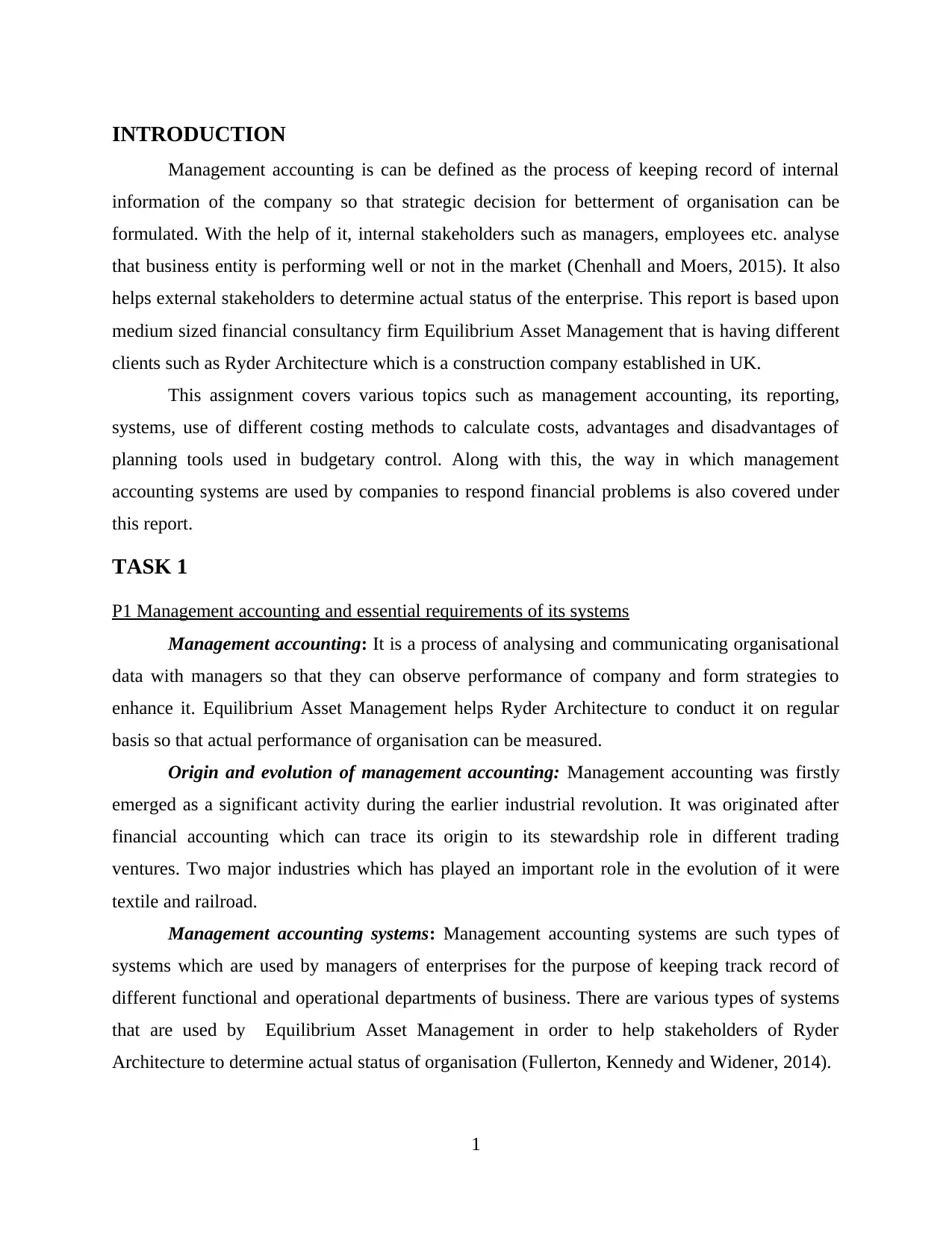
INTRODUCTION
Management accounting is can be defined as the process of keeping record of internal
information of the company so that strategic decision for betterment of organisation can be
formulated. With the help of it, internal stakeholders such as managers, employees etc. analyse
that business entity is performing well or not in the market (Chenhall and Moers, 2015). It also
helps external stakeholders to determine actual status of the enterprise. This report is based upon
medium sized financial consultancy firm Equilibrium Asset Management that is having different
clients such as Ryder Architecture which is a construction company established in UK.
This assignment covers various topics such as management accounting, its reporting,
systems, use of different costing methods to calculate costs, advantages and disadvantages of
planning tools used in budgetary control. Along with this, the way in which management
accounting systems are used by companies to respond financial problems is also covered under
this report.
TASK 1
P1 Management accounting and essential requirements of its systems
Management accounting: It is a process of analysing and communicating organisational
data with managers so that they can observe performance of company and form strategies to
enhance it. Equilibrium Asset Management helps Ryder Architecture to conduct it on regular
basis so that actual performance of organisation can be measured.
Origin and evolution of management accounting: Management accounting was firstly
emerged as a significant activity during the earlier industrial revolution. It was originated after
financial accounting which can trace its origin to its stewardship role in different trading
ventures. Two major industries which has played an important role in the evolution of it were
textile and railroad.
Management accounting systems: Management accounting systems are such types of
systems which are used by managers of enterprises for the purpose of keeping track record of
different functional and operational departments of business. There are various types of systems
that are used by Equilibrium Asset Management in order to help stakeholders of Ryder
Architecture to determine actual status of organisation (Fullerton, Kennedy and Widener, 2014).
1
Management accounting is can be defined as the process of keeping record of internal
information of the company so that strategic decision for betterment of organisation can be
formulated. With the help of it, internal stakeholders such as managers, employees etc. analyse
that business entity is performing well or not in the market (Chenhall and Moers, 2015). It also
helps external stakeholders to determine actual status of the enterprise. This report is based upon
medium sized financial consultancy firm Equilibrium Asset Management that is having different
clients such as Ryder Architecture which is a construction company established in UK.
This assignment covers various topics such as management accounting, its reporting,
systems, use of different costing methods to calculate costs, advantages and disadvantages of
planning tools used in budgetary control. Along with this, the way in which management
accounting systems are used by companies to respond financial problems is also covered under
this report.
TASK 1
P1 Management accounting and essential requirements of its systems
Management accounting: It is a process of analysing and communicating organisational
data with managers so that they can observe performance of company and form strategies to
enhance it. Equilibrium Asset Management helps Ryder Architecture to conduct it on regular
basis so that actual performance of organisation can be measured.
Origin and evolution of management accounting: Management accounting was firstly
emerged as a significant activity during the earlier industrial revolution. It was originated after
financial accounting which can trace its origin to its stewardship role in different trading
ventures. Two major industries which has played an important role in the evolution of it were
textile and railroad.
Management accounting systems: Management accounting systems are such types of
systems which are used by managers of enterprises for the purpose of keeping track record of
different functional and operational departments of business. There are various types of systems
that are used by Equilibrium Asset Management in order to help stakeholders of Ryder
Architecture to determine actual status of organisation (Fullerton, Kennedy and Widener, 2014).
1
⊘ This is a preview!⊘
Do you want full access?
Subscribe today to unlock all pages.

Trusted by 1+ million students worldwide
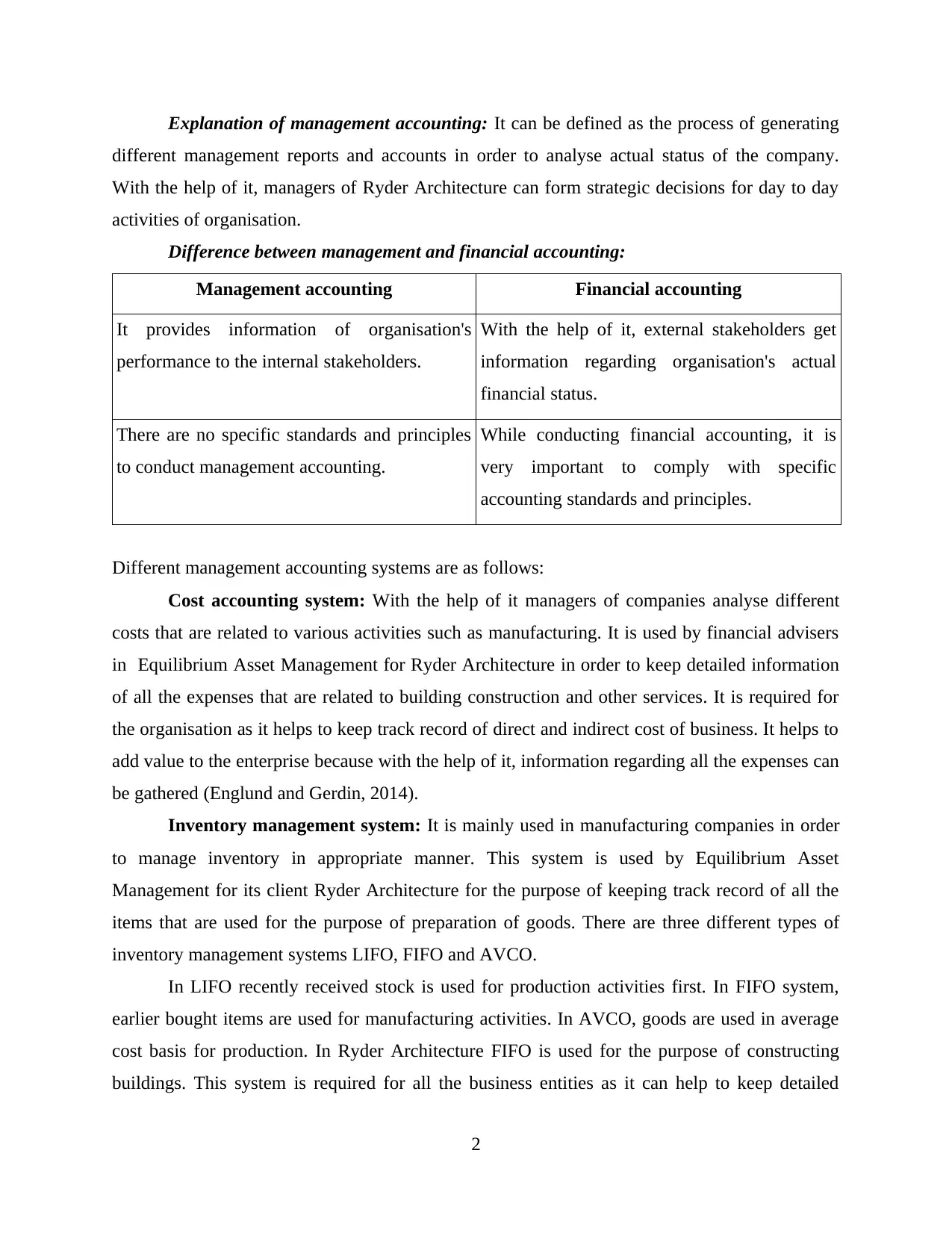
Explanation of management accounting: It can be defined as the process of generating
different management reports and accounts in order to analyse actual status of the company.
With the help of it, managers of Ryder Architecture can form strategic decisions for day to day
activities of organisation.
Difference between management and financial accounting:
Management accounting Financial accounting
It provides information of organisation's
performance to the internal stakeholders.
With the help of it, external stakeholders get
information regarding organisation's actual
financial status.
There are no specific standards and principles
to conduct management accounting.
While conducting financial accounting, it is
very important to comply with specific
accounting standards and principles.
Different management accounting systems are as follows:
Cost accounting system: With the help of it managers of companies analyse different
costs that are related to various activities such as manufacturing. It is used by financial advisers
in Equilibrium Asset Management for Ryder Architecture in order to keep detailed information
of all the expenses that are related to building construction and other services. It is required for
the organisation as it helps to keep track record of direct and indirect cost of business. It helps to
add value to the enterprise because with the help of it, information regarding all the expenses can
be gathered (Englund and Gerdin, 2014).
Inventory management system: It is mainly used in manufacturing companies in order
to manage inventory in appropriate manner. This system is used by Equilibrium Asset
Management for its client Ryder Architecture for the purpose of keeping track record of all the
items that are used for the purpose of preparation of goods. There are three different types of
inventory management systems LIFO, FIFO and AVCO.
In LIFO recently received stock is used for production activities first. In FIFO system,
earlier bought items are used for manufacturing activities. In AVCO, goods are used in average
cost basis for production. In Ryder Architecture FIFO is used for the purpose of constructing
buildings. This system is required for all the business entities as it can help to keep detailed
2
different management reports and accounts in order to analyse actual status of the company.
With the help of it, managers of Ryder Architecture can form strategic decisions for day to day
activities of organisation.
Difference between management and financial accounting:
Management accounting Financial accounting
It provides information of organisation's
performance to the internal stakeholders.
With the help of it, external stakeholders get
information regarding organisation's actual
financial status.
There are no specific standards and principles
to conduct management accounting.
While conducting financial accounting, it is
very important to comply with specific
accounting standards and principles.
Different management accounting systems are as follows:
Cost accounting system: With the help of it managers of companies analyse different
costs that are related to various activities such as manufacturing. It is used by financial advisers
in Equilibrium Asset Management for Ryder Architecture in order to keep detailed information
of all the expenses that are related to building construction and other services. It is required for
the organisation as it helps to keep track record of direct and indirect cost of business. It helps to
add value to the enterprise because with the help of it, information regarding all the expenses can
be gathered (Englund and Gerdin, 2014).
Inventory management system: It is mainly used in manufacturing companies in order
to manage inventory in appropriate manner. This system is used by Equilibrium Asset
Management for its client Ryder Architecture for the purpose of keeping track record of all the
items that are used for the purpose of preparation of goods. There are three different types of
inventory management systems LIFO, FIFO and AVCO.
In LIFO recently received stock is used for production activities first. In FIFO system,
earlier bought items are used for manufacturing activities. In AVCO, goods are used in average
cost basis for production. In Ryder Architecture FIFO is used for the purpose of constructing
buildings. This system is required for all the business entities as it can help to keep detailed
2
Paraphrase This Document
Need a fresh take? Get an instant paraphrase of this document with our AI Paraphraser
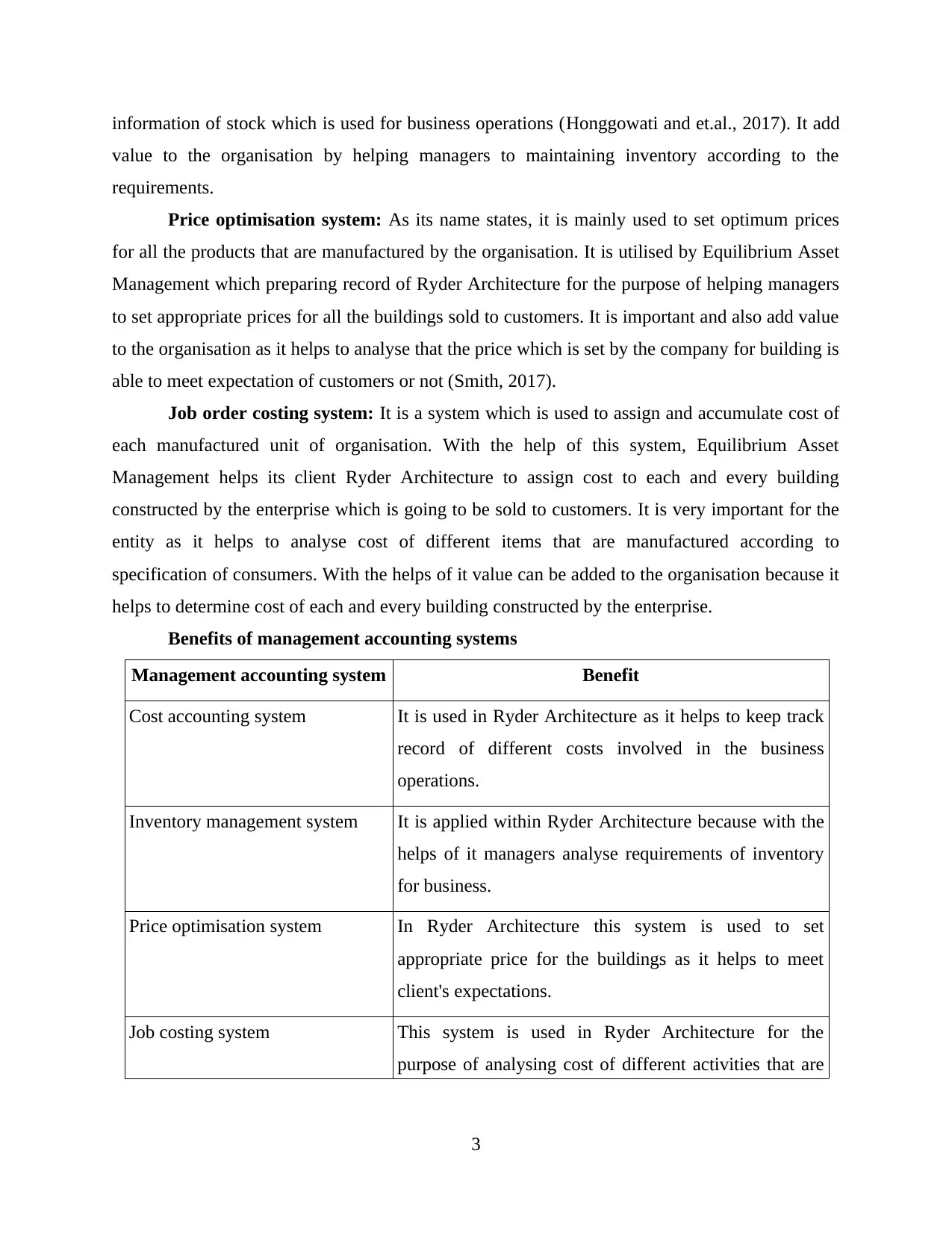
information of stock which is used for business operations (Honggowati and et.al., 2017). It add
value to the organisation by helping managers to maintaining inventory according to the
requirements.
Price optimisation system: As its name states, it is mainly used to set optimum prices
for all the products that are manufactured by the organisation. It is utilised by Equilibrium Asset
Management which preparing record of Ryder Architecture for the purpose of helping managers
to set appropriate prices for all the buildings sold to customers. It is important and also add value
to the organisation as it helps to analyse that the price which is set by the company for building is
able to meet expectation of customers or not (Smith, 2017).
Job order costing system: It is a system which is used to assign and accumulate cost of
each manufactured unit of organisation. With the help of this system, Equilibrium Asset
Management helps its client Ryder Architecture to assign cost to each and every building
constructed by the enterprise which is going to be sold to customers. It is very important for the
entity as it helps to analyse cost of different items that are manufactured according to
specification of consumers. With the helps of it value can be added to the organisation because it
helps to determine cost of each and every building constructed by the enterprise.
Benefits of management accounting systems
Management accounting system Benefit
Cost accounting system It is used in Ryder Architecture as it helps to keep track
record of different costs involved in the business
operations.
Inventory management system It is applied within Ryder Architecture because with the
helps of it managers analyse requirements of inventory
for business.
Price optimisation system In Ryder Architecture this system is used to set
appropriate price for the buildings as it helps to meet
client's expectations.
Job costing system This system is used in Ryder Architecture for the
purpose of analysing cost of different activities that are
3
value to the organisation by helping managers to maintaining inventory according to the
requirements.
Price optimisation system: As its name states, it is mainly used to set optimum prices
for all the products that are manufactured by the organisation. It is utilised by Equilibrium Asset
Management which preparing record of Ryder Architecture for the purpose of helping managers
to set appropriate prices for all the buildings sold to customers. It is important and also add value
to the organisation as it helps to analyse that the price which is set by the company for building is
able to meet expectation of customers or not (Smith, 2017).
Job order costing system: It is a system which is used to assign and accumulate cost of
each manufactured unit of organisation. With the help of this system, Equilibrium Asset
Management helps its client Ryder Architecture to assign cost to each and every building
constructed by the enterprise which is going to be sold to customers. It is very important for the
entity as it helps to analyse cost of different items that are manufactured according to
specification of consumers. With the helps of it value can be added to the organisation because it
helps to determine cost of each and every building constructed by the enterprise.
Benefits of management accounting systems
Management accounting system Benefit
Cost accounting system It is used in Ryder Architecture as it helps to keep track
record of different costs involved in the business
operations.
Inventory management system It is applied within Ryder Architecture because with the
helps of it managers analyse requirements of inventory
for business.
Price optimisation system In Ryder Architecture this system is used to set
appropriate price for the buildings as it helps to meet
client's expectations.
Job costing system This system is used in Ryder Architecture for the
purpose of analysing cost of different activities that are
3
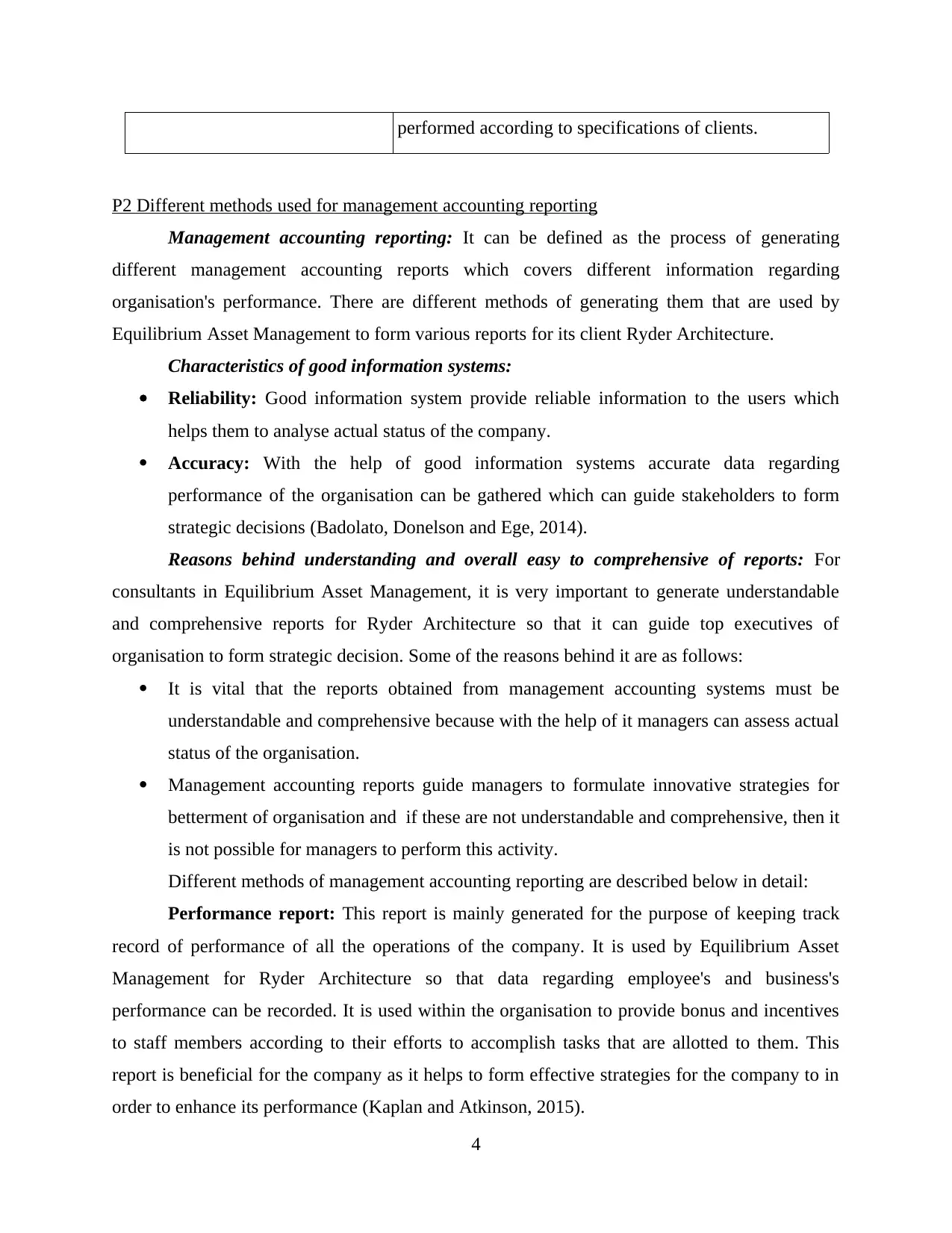
performed according to specifications of clients.
P2 Different methods used for management accounting reporting
Management accounting reporting: It can be defined as the process of generating
different management accounting reports which covers different information regarding
organisation's performance. There are different methods of generating them that are used by
Equilibrium Asset Management to form various reports for its client Ryder Architecture.
Characteristics of good information systems:
Reliability: Good information system provide reliable information to the users which
helps them to analyse actual status of the company.
Accuracy: With the help of good information systems accurate data regarding
performance of the organisation can be gathered which can guide stakeholders to form
strategic decisions (Badolato, Donelson and Ege, 2014).
Reasons behind understanding and overall easy to comprehensive of reports: For
consultants in Equilibrium Asset Management, it is very important to generate understandable
and comprehensive reports for Ryder Architecture so that it can guide top executives of
organisation to form strategic decision. Some of the reasons behind it are as follows:
It is vital that the reports obtained from management accounting systems must be
understandable and comprehensive because with the help of it managers can assess actual
status of the organisation.
Management accounting reports guide managers to formulate innovative strategies for
betterment of organisation and if these are not understandable and comprehensive, then it
is not possible for managers to perform this activity.
Different methods of management accounting reporting are described below in detail:
Performance report: This report is mainly generated for the purpose of keeping track
record of performance of all the operations of the company. It is used by Equilibrium Asset
Management for Ryder Architecture so that data regarding employee's and business's
performance can be recorded. It is used within the organisation to provide bonus and incentives
to staff members according to their efforts to accomplish tasks that are allotted to them. This
report is beneficial for the company as it helps to form effective strategies for the company to in
order to enhance its performance (Kaplan and Atkinson, 2015).
4
P2 Different methods used for management accounting reporting
Management accounting reporting: It can be defined as the process of generating
different management accounting reports which covers different information regarding
organisation's performance. There are different methods of generating them that are used by
Equilibrium Asset Management to form various reports for its client Ryder Architecture.
Characteristics of good information systems:
Reliability: Good information system provide reliable information to the users which
helps them to analyse actual status of the company.
Accuracy: With the help of good information systems accurate data regarding
performance of the organisation can be gathered which can guide stakeholders to form
strategic decisions (Badolato, Donelson and Ege, 2014).
Reasons behind understanding and overall easy to comprehensive of reports: For
consultants in Equilibrium Asset Management, it is very important to generate understandable
and comprehensive reports for Ryder Architecture so that it can guide top executives of
organisation to form strategic decision. Some of the reasons behind it are as follows:
It is vital that the reports obtained from management accounting systems must be
understandable and comprehensive because with the help of it managers can assess actual
status of the organisation.
Management accounting reports guide managers to formulate innovative strategies for
betterment of organisation and if these are not understandable and comprehensive, then it
is not possible for managers to perform this activity.
Different methods of management accounting reporting are described below in detail:
Performance report: This report is mainly generated for the purpose of keeping track
record of performance of all the operations of the company. It is used by Equilibrium Asset
Management for Ryder Architecture so that data regarding employee's and business's
performance can be recorded. It is used within the organisation to provide bonus and incentives
to staff members according to their efforts to accomplish tasks that are allotted to them. This
report is beneficial for the company as it helps to form effective strategies for the company to in
order to enhance its performance (Kaplan and Atkinson, 2015).
4
⊘ This is a preview!⊘
Do you want full access?
Subscribe today to unlock all pages.

Trusted by 1+ million students worldwide
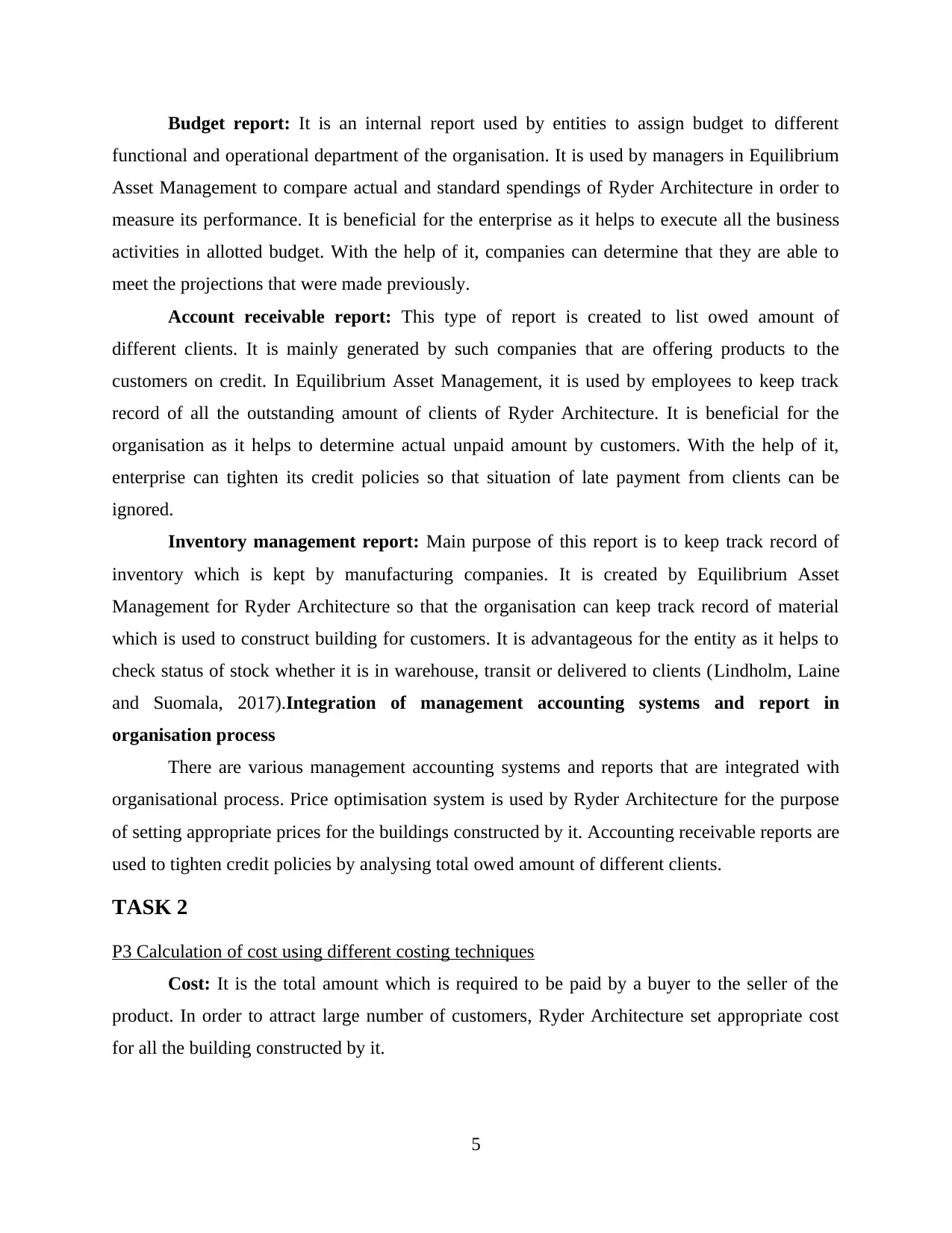
Budget report: It is an internal report used by entities to assign budget to different
functional and operational department of the organisation. It is used by managers in Equilibrium
Asset Management to compare actual and standard spendings of Ryder Architecture in order to
measure its performance. It is beneficial for the enterprise as it helps to execute all the business
activities in allotted budget. With the help of it, companies can determine that they are able to
meet the projections that were made previously.
Account receivable report: This type of report is created to list owed amount of
different clients. It is mainly generated by such companies that are offering products to the
customers on credit. In Equilibrium Asset Management, it is used by employees to keep track
record of all the outstanding amount of clients of Ryder Architecture. It is beneficial for the
organisation as it helps to determine actual unpaid amount by customers. With the help of it,
enterprise can tighten its credit policies so that situation of late payment from clients can be
ignored.
Inventory management report: Main purpose of this report is to keep track record of
inventory which is kept by manufacturing companies. It is created by Equilibrium Asset
Management for Ryder Architecture so that the organisation can keep track record of material
which is used to construct building for customers. It is advantageous for the entity as it helps to
check status of stock whether it is in warehouse, transit or delivered to clients (Lindholm, Laine
and Suomala, 2017).Integration of management accounting systems and report in
organisation process
There are various management accounting systems and reports that are integrated with
organisational process. Price optimisation system is used by Ryder Architecture for the purpose
of setting appropriate prices for the buildings constructed by it. Accounting receivable reports are
used to tighten credit policies by analysing total owed amount of different clients.
TASK 2
P3 Calculation of cost using different costing techniques
Cost: It is the total amount which is required to be paid by a buyer to the seller of the
product. In order to attract large number of customers, Ryder Architecture set appropriate cost
for all the building constructed by it.
5
functional and operational department of the organisation. It is used by managers in Equilibrium
Asset Management to compare actual and standard spendings of Ryder Architecture in order to
measure its performance. It is beneficial for the enterprise as it helps to execute all the business
activities in allotted budget. With the help of it, companies can determine that they are able to
meet the projections that were made previously.
Account receivable report: This type of report is created to list owed amount of
different clients. It is mainly generated by such companies that are offering products to the
customers on credit. In Equilibrium Asset Management, it is used by employees to keep track
record of all the outstanding amount of clients of Ryder Architecture. It is beneficial for the
organisation as it helps to determine actual unpaid amount by customers. With the help of it,
enterprise can tighten its credit policies so that situation of late payment from clients can be
ignored.
Inventory management report: Main purpose of this report is to keep track record of
inventory which is kept by manufacturing companies. It is created by Equilibrium Asset
Management for Ryder Architecture so that the organisation can keep track record of material
which is used to construct building for customers. It is advantageous for the entity as it helps to
check status of stock whether it is in warehouse, transit or delivered to clients (Lindholm, Laine
and Suomala, 2017).Integration of management accounting systems and report in
organisation process
There are various management accounting systems and reports that are integrated with
organisational process. Price optimisation system is used by Ryder Architecture for the purpose
of setting appropriate prices for the buildings constructed by it. Accounting receivable reports are
used to tighten credit policies by analysing total owed amount of different clients.
TASK 2
P3 Calculation of cost using different costing techniques
Cost: It is the total amount which is required to be paid by a buyer to the seller of the
product. In order to attract large number of customers, Ryder Architecture set appropriate cost
for all the building constructed by it.
5
Paraphrase This Document
Need a fresh take? Get an instant paraphrase of this document with our AI Paraphraser
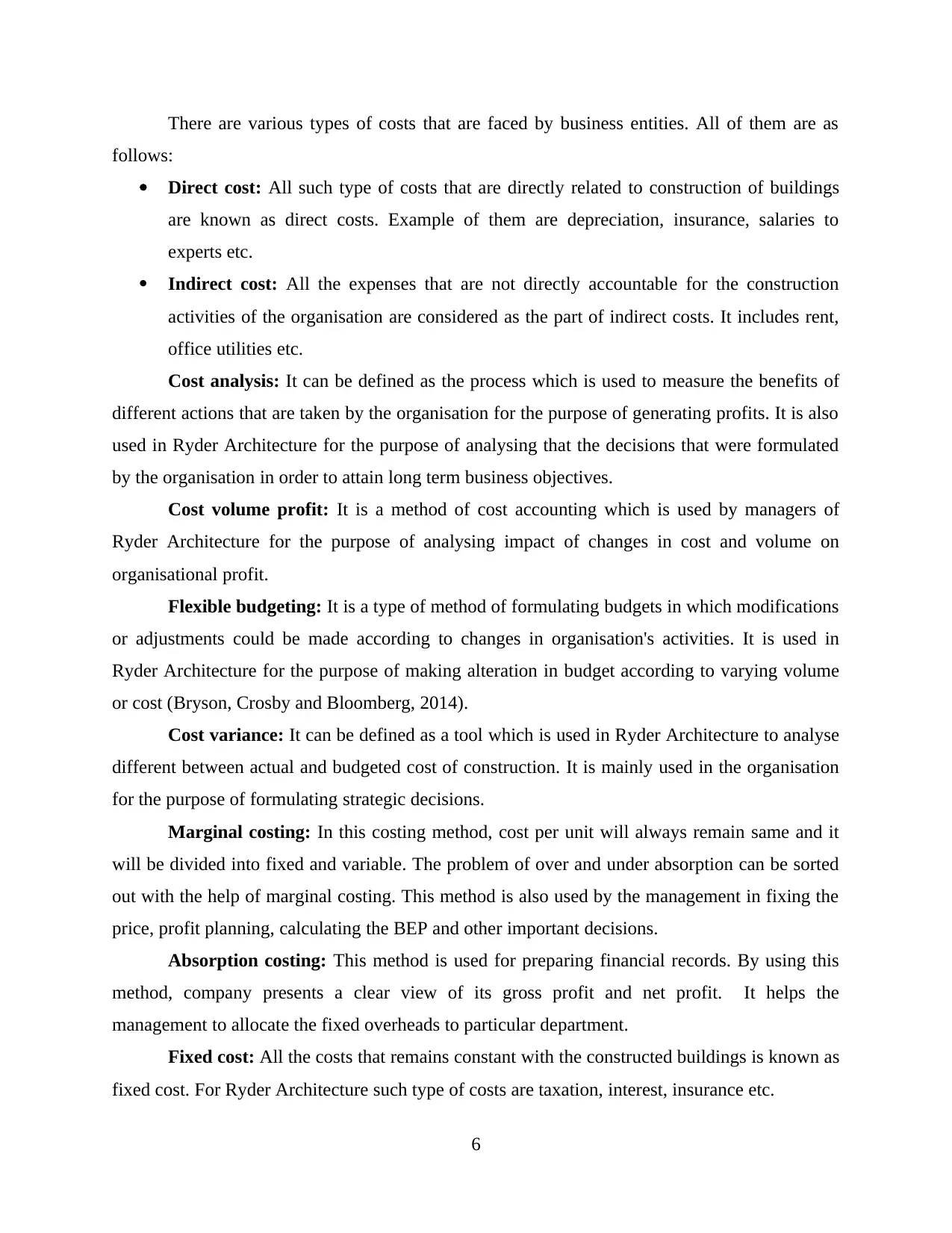
There are various types of costs that are faced by business entities. All of them are as
follows:
Direct cost: All such type of costs that are directly related to construction of buildings
are known as direct costs. Example of them are depreciation, insurance, salaries to
experts etc.
Indirect cost: All the expenses that are not directly accountable for the construction
activities of the organisation are considered as the part of indirect costs. It includes rent,
office utilities etc.
Cost analysis: It can be defined as the process which is used to measure the benefits of
different actions that are taken by the organisation for the purpose of generating profits. It is also
used in Ryder Architecture for the purpose of analysing that the decisions that were formulated
by the organisation in order to attain long term business objectives.
Cost volume profit: It is a method of cost accounting which is used by managers of
Ryder Architecture for the purpose of analysing impact of changes in cost and volume on
organisational profit.
Flexible budgeting: It is a type of method of formulating budgets in which modifications
or adjustments could be made according to changes in organisation's activities. It is used in
Ryder Architecture for the purpose of making alteration in budget according to varying volume
or cost (Bryson, Crosby and Bloomberg, 2014).
Cost variance: It can be defined as a tool which is used in Ryder Architecture to analyse
different between actual and budgeted cost of construction. It is mainly used in the organisation
for the purpose of formulating strategic decisions.
Marginal costing: In this costing method, cost per unit will always remain same and it
will be divided into fixed and variable. The problem of over and under absorption can be sorted
out with the help of marginal costing. This method is also used by the management in fixing the
price, profit planning, calculating the BEP and other important decisions.
Absorption costing: This method is used for preparing financial records. By using this
method, company presents a clear view of its gross profit and net profit. It helps the
management to allocate the fixed overheads to particular department.
Fixed cost: All the costs that remains constant with the constructed buildings is known as
fixed cost. For Ryder Architecture such type of costs are taxation, interest, insurance etc.
6
follows:
Direct cost: All such type of costs that are directly related to construction of buildings
are known as direct costs. Example of them are depreciation, insurance, salaries to
experts etc.
Indirect cost: All the expenses that are not directly accountable for the construction
activities of the organisation are considered as the part of indirect costs. It includes rent,
office utilities etc.
Cost analysis: It can be defined as the process which is used to measure the benefits of
different actions that are taken by the organisation for the purpose of generating profits. It is also
used in Ryder Architecture for the purpose of analysing that the decisions that were formulated
by the organisation in order to attain long term business objectives.
Cost volume profit: It is a method of cost accounting which is used by managers of
Ryder Architecture for the purpose of analysing impact of changes in cost and volume on
organisational profit.
Flexible budgeting: It is a type of method of formulating budgets in which modifications
or adjustments could be made according to changes in organisation's activities. It is used in
Ryder Architecture for the purpose of making alteration in budget according to varying volume
or cost (Bryson, Crosby and Bloomberg, 2014).
Cost variance: It can be defined as a tool which is used in Ryder Architecture to analyse
different between actual and budgeted cost of construction. It is mainly used in the organisation
for the purpose of formulating strategic decisions.
Marginal costing: In this costing method, cost per unit will always remain same and it
will be divided into fixed and variable. The problem of over and under absorption can be sorted
out with the help of marginal costing. This method is also used by the management in fixing the
price, profit planning, calculating the BEP and other important decisions.
Absorption costing: This method is used for preparing financial records. By using this
method, company presents a clear view of its gross profit and net profit. It helps the
management to allocate the fixed overheads to particular department.
Fixed cost: All the costs that remains constant with the constructed buildings is known as
fixed cost. For Ryder Architecture such type of costs are taxation, interest, insurance etc.
6
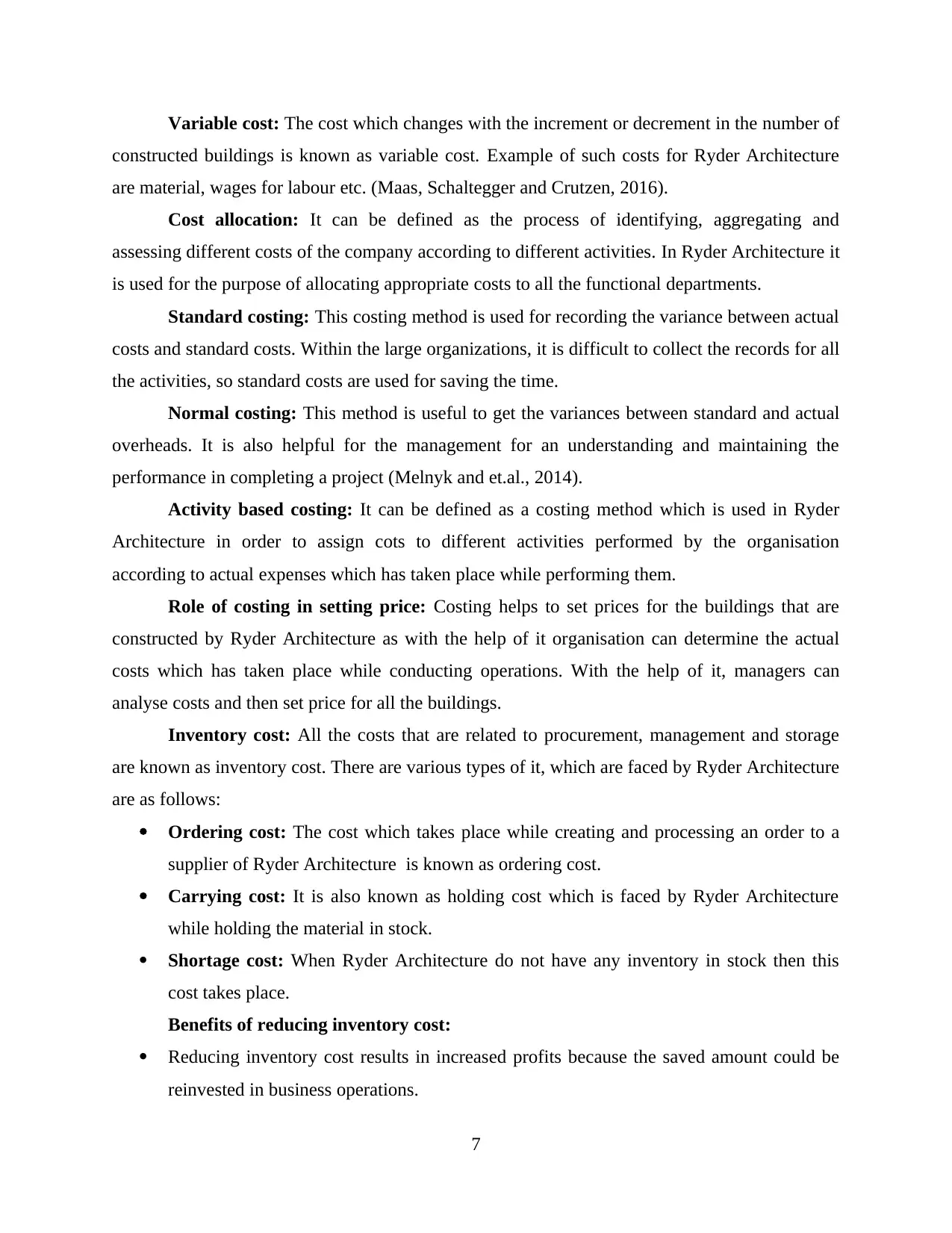
Variable cost: The cost which changes with the increment or decrement in the number of
constructed buildings is known as variable cost. Example of such costs for Ryder Architecture
are material, wages for labour etc. (Maas, Schaltegger and Crutzen, 2016).
Cost allocation: It can be defined as the process of identifying, aggregating and
assessing different costs of the company according to different activities. In Ryder Architecture it
is used for the purpose of allocating appropriate costs to all the functional departments.
Standard costing: This costing method is used for recording the variance between actual
costs and standard costs. Within the large organizations, it is difficult to collect the records for all
the activities, so standard costs are used for saving the time.
Normal costing: This method is useful to get the variances between standard and actual
overheads. It is also helpful for the management for an understanding and maintaining the
performance in completing a project (Melnyk and et.al., 2014).
Activity based costing: It can be defined as a costing method which is used in Ryder
Architecture in order to assign cots to different activities performed by the organisation
according to actual expenses which has taken place while performing them.
Role of costing in setting price: Costing helps to set prices for the buildings that are
constructed by Ryder Architecture as with the help of it organisation can determine the actual
costs which has taken place while conducting operations. With the help of it, managers can
analyse costs and then set price for all the buildings.
Inventory cost: All the costs that are related to procurement, management and storage
are known as inventory cost. There are various types of it, which are faced by Ryder Architecture
are as follows:
Ordering cost: The cost which takes place while creating and processing an order to a
supplier of Ryder Architecture is known as ordering cost.
Carrying cost: It is also known as holding cost which is faced by Ryder Architecture
while holding the material in stock.
Shortage cost: When Ryder Architecture do not have any inventory in stock then this
cost takes place.
Benefits of reducing inventory cost:
Reducing inventory cost results in increased profits because the saved amount could be
reinvested in business operations.
7
constructed buildings is known as variable cost. Example of such costs for Ryder Architecture
are material, wages for labour etc. (Maas, Schaltegger and Crutzen, 2016).
Cost allocation: It can be defined as the process of identifying, aggregating and
assessing different costs of the company according to different activities. In Ryder Architecture it
is used for the purpose of allocating appropriate costs to all the functional departments.
Standard costing: This costing method is used for recording the variance between actual
costs and standard costs. Within the large organizations, it is difficult to collect the records for all
the activities, so standard costs are used for saving the time.
Normal costing: This method is useful to get the variances between standard and actual
overheads. It is also helpful for the management for an understanding and maintaining the
performance in completing a project (Melnyk and et.al., 2014).
Activity based costing: It can be defined as a costing method which is used in Ryder
Architecture in order to assign cots to different activities performed by the organisation
according to actual expenses which has taken place while performing them.
Role of costing in setting price: Costing helps to set prices for the buildings that are
constructed by Ryder Architecture as with the help of it organisation can determine the actual
costs which has taken place while conducting operations. With the help of it, managers can
analyse costs and then set price for all the buildings.
Inventory cost: All the costs that are related to procurement, management and storage
are known as inventory cost. There are various types of it, which are faced by Ryder Architecture
are as follows:
Ordering cost: The cost which takes place while creating and processing an order to a
supplier of Ryder Architecture is known as ordering cost.
Carrying cost: It is also known as holding cost which is faced by Ryder Architecture
while holding the material in stock.
Shortage cost: When Ryder Architecture do not have any inventory in stock then this
cost takes place.
Benefits of reducing inventory cost:
Reducing inventory cost results in increased profits because the saved amount could be
reinvested in business operations.
7
⊘ This is a preview!⊘
Do you want full access?
Subscribe today to unlock all pages.

Trusted by 1+ million students worldwide
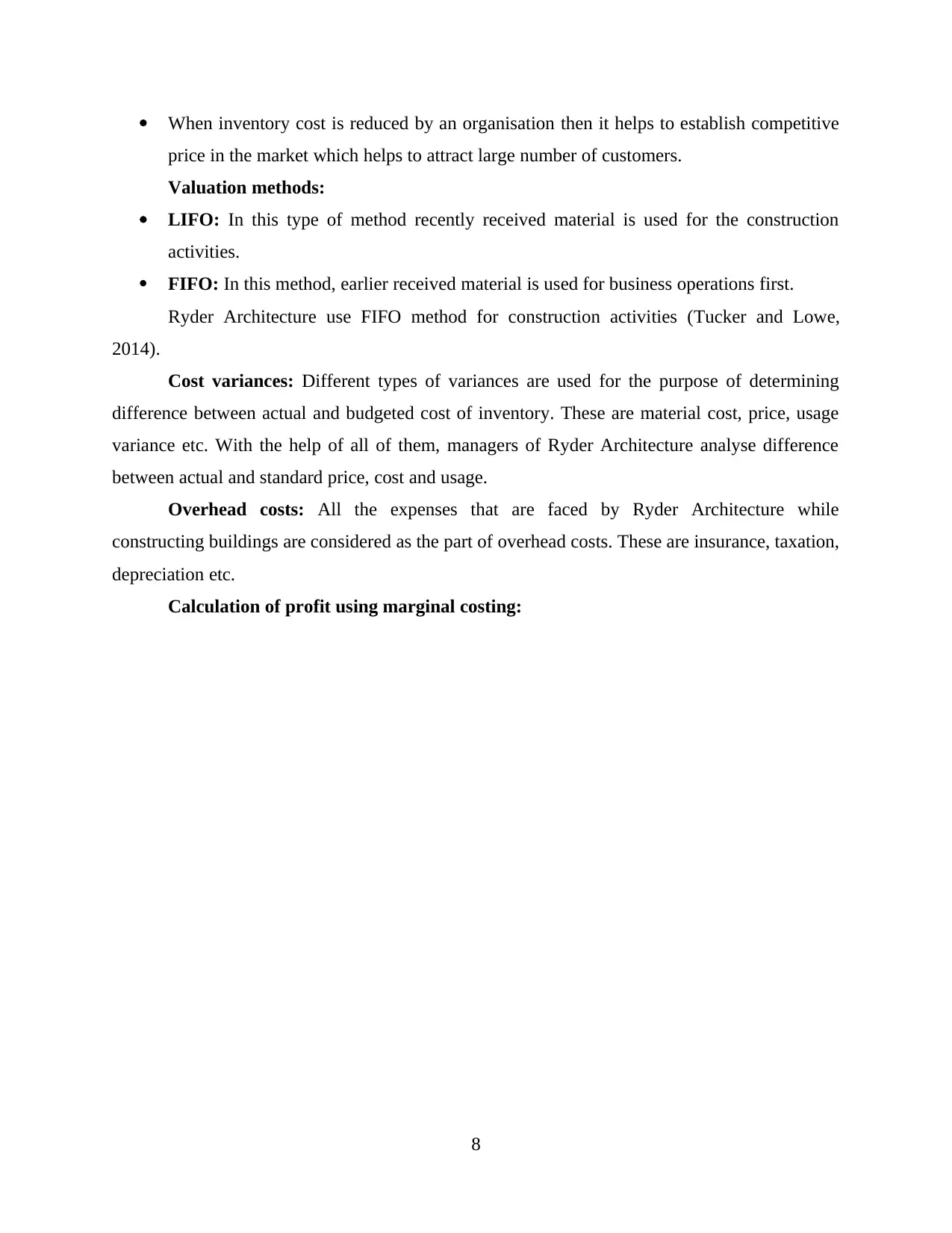
When inventory cost is reduced by an organisation then it helps to establish competitive
price in the market which helps to attract large number of customers.
Valuation methods:
LIFO: In this type of method recently received material is used for the construction
activities.
FIFO: In this method, earlier received material is used for business operations first.
Ryder Architecture use FIFO method for construction activities (Tucker and Lowe,
2014).
Cost variances: Different types of variances are used for the purpose of determining
difference between actual and budgeted cost of inventory. These are material cost, price, usage
variance etc. With the help of all of them, managers of Ryder Architecture analyse difference
between actual and standard price, cost and usage.
Overhead costs: All the expenses that are faced by Ryder Architecture while
constructing buildings are considered as the part of overhead costs. These are insurance, taxation,
depreciation etc.
Calculation of profit using marginal costing:
8
price in the market which helps to attract large number of customers.
Valuation methods:
LIFO: In this type of method recently received material is used for the construction
activities.
FIFO: In this method, earlier received material is used for business operations first.
Ryder Architecture use FIFO method for construction activities (Tucker and Lowe,
2014).
Cost variances: Different types of variances are used for the purpose of determining
difference between actual and budgeted cost of inventory. These are material cost, price, usage
variance etc. With the help of all of them, managers of Ryder Architecture analyse difference
between actual and standard price, cost and usage.
Overhead costs: All the expenses that are faced by Ryder Architecture while
constructing buildings are considered as the part of overhead costs. These are insurance, taxation,
depreciation etc.
Calculation of profit using marginal costing:
8
Paraphrase This Document
Need a fresh take? Get an instant paraphrase of this document with our AI Paraphraser
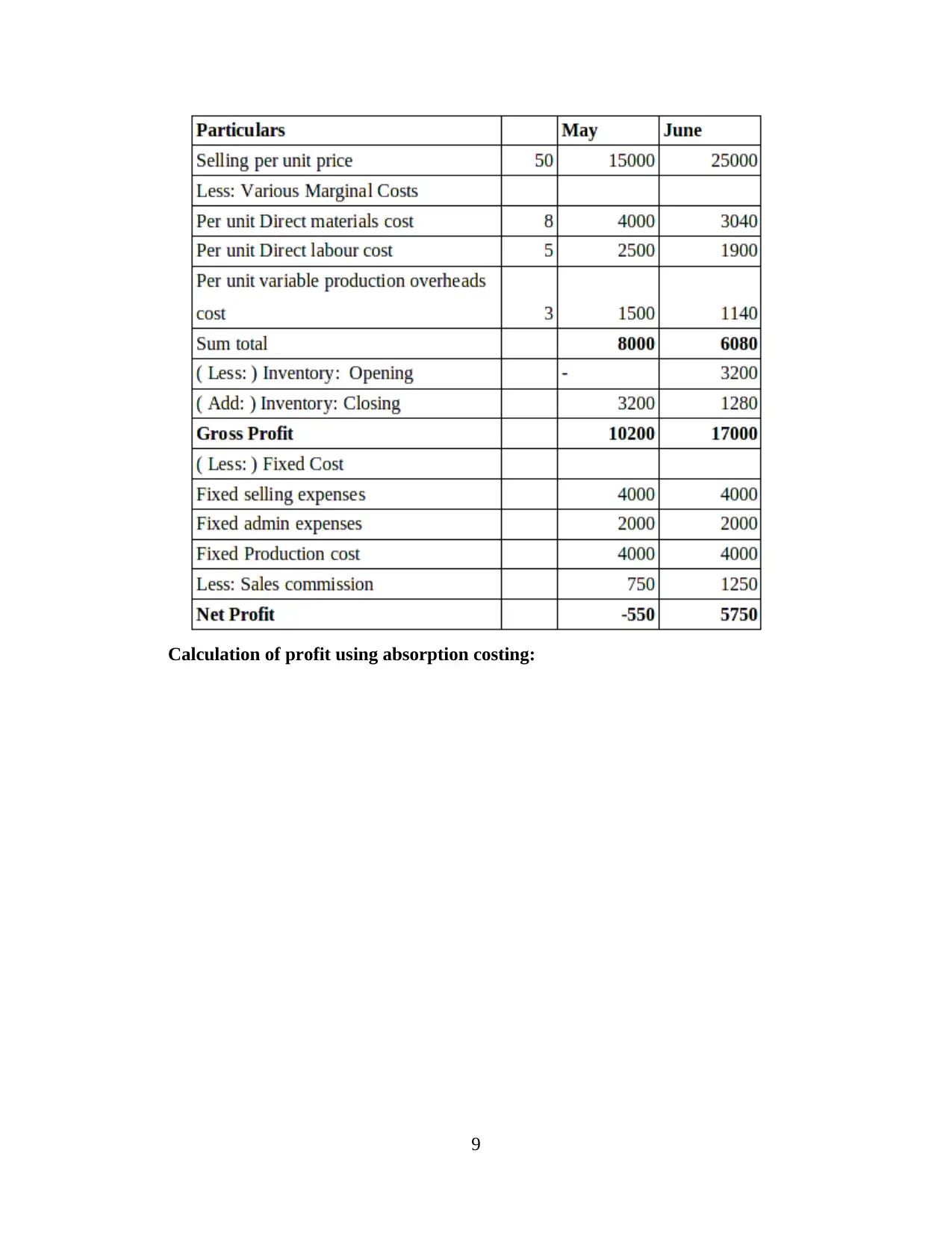
Calculation of profit using absorption costing:
9
9
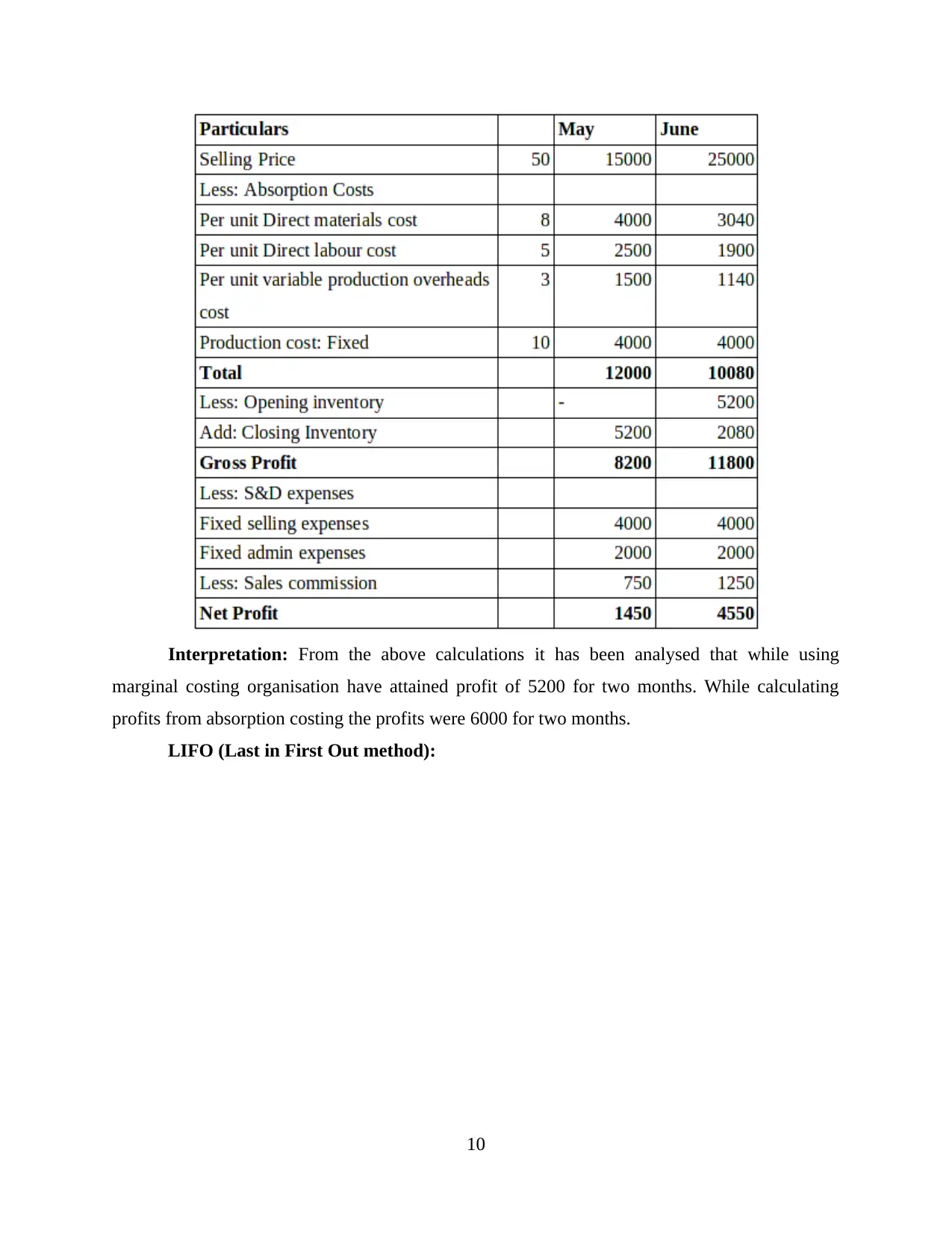
Interpretation: From the above calculations it has been analysed that while using
marginal costing organisation have attained profit of 5200 for two months. While calculating
profits from absorption costing the profits were 6000 for two months.
LIFO (Last in First Out method):
10
marginal costing organisation have attained profit of 5200 for two months. While calculating
profits from absorption costing the profits were 6000 for two months.
LIFO (Last in First Out method):
10
⊘ This is a preview!⊘
Do you want full access?
Subscribe today to unlock all pages.

Trusted by 1+ million students worldwide
1 out of 22
Related Documents
Your All-in-One AI-Powered Toolkit for Academic Success.
+13062052269
info@desklib.com
Available 24*7 on WhatsApp / Email
![[object Object]](/_next/static/media/star-bottom.7253800d.svg)
Unlock your academic potential
Copyright © 2020–2025 A2Z Services. All Rights Reserved. Developed and managed by ZUCOL.




